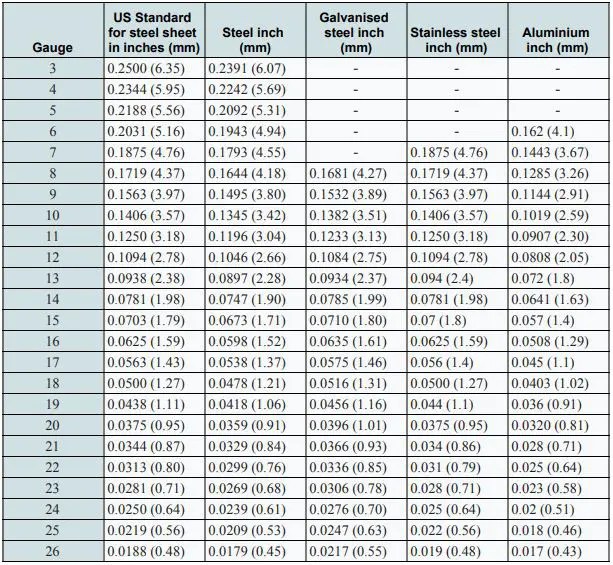Standard Steel Sheet Thickness
Standard Steel Sheet Thickness - For the purpose of securing uniformity the following is established as the only standard gauge for sheet and plate iron and steel in the united states of america, namely: 16 gauge = 1.519 mm. Web a chart of sheet metal thicknesses converted to gauge and inches. Web a sheet metal gauge chart serves as a valuable tool for understanding the thickness of sheet metal materials. In the sheet metal fabrication industry, the term ‘gauge’ is used to specify the thickness or size of sheet metals. Anything thicker 6 millimetres is classified as metal plate, and anything.
Gauge are used to specify the thickness of a metal sheet. In the sheet metal fabrication industry, the term ‘gauge’ is used to specify the thickness or size of sheet metals. Web a gauge conversion chart can be used to determine the actual thickness of sheet metal in inches or millimeters. Yet those numbers do not indicate a specific dimensional value. Covers aluminum, stainless steel, galvanized steel, and sheet steel.
If you are unfamiliar with the sheet metal industry or gauge system, you would be confused by the phrase ‘18 gauge steel’. 16 gauge = 1.519 mm. Web what is the standard thickness of sheet metal? Commonly used metals for manufacturing at our shop are: Web sheet metal thickness (gauge) chart in inches gauge mild steel aluminum galvanized steel stainless steel 3 0.2391 0.2294 0.2500 4 0.2242 0.2043 0.2344 5 0.2092 0.1819 0.2187 6 0.1943 0.1620 0.2031 7 0.1793 0.1443 0.1875 8 0.1644 0.1285 0.1680 0.1719 9 0.1495 0.1144 0.1532 0.1562 Web the chart below can be used to determine the equivalent sheet thickness, in inches or millimeters, for a gauge number from the selected gauge size standard.
Web what is the standard thickness of sheet metal? 16 gauge = 1.588 mm. For example, 18 gauge steel, according to a gauge conversion chart, is 0.0478 inch or 1.214 millimeter.
Web Sheet Metal Gauge Thickness Chart ( To Mm/Inch Comversation) Standard Steel.
Below you will find a chart for metal thicknesses and weights. For example, 18 gauge steel, according to a gauge conversion chart, is 0.0478 inch or 1.214 millimeter. In the sheet metal fabrication industry, the term ‘gauge’ is used to specify the thickness or size of sheet metals. Web sheet metal gauge is a fundamental measurement in metalworking that denotes the thickness of sheet metal.
When Working With Sheet Metal, The Term “Gauge” Is Often Used.
Understanding these nuanced differences is vital when consulting a metal gauge chart to ensure that you're selecting the appropriate material for your endeavor. Standard gauge size for sheet & plate iron / steel. What are sheet metal gauges? Below are sheet metal gauge charts for common metals.
16 Gauge = 1.29 Mm.
Yet those numbers do not indicate a specific dimensional value. Web below is our best attempt to capture all of the standard gauge thickness of different materials. Web understanding these gauge numbers, which indicate material thickness in millimeters or thousandths of an inch, is crucial for selecting the right sheet metal for your project. If you are unfamiliar with the sheet metal industry or gauge system, you would be confused by the phrase ‘18 gauge steel’.
Web A Chart Of Sheet Metal Thicknesses Converted To Gauge And Inches.
Web a sheet metal gauge chart serves as a valuable tool for understanding the thickness of sheet metal materials. Commonly used metals for manufacturing at our shop are: 16 gauge, 14 gauge, 1/8 and 1/4. Web the term gauge steel is often used to refer to the thickness of sheet metal made of steel.




